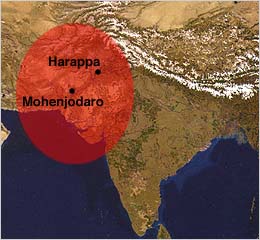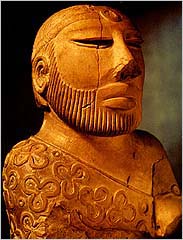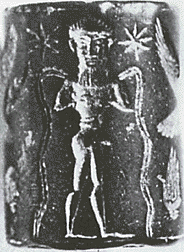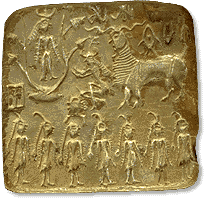

 One of the most fascinating yet mysterious cultures of the ancient world is the Harappan civilization.
This culture existed along the Indus River in present day Pakistan. It was named after the city of
Harappa which it was centered around. Harappa and the city of Mohenjo-Daro were the greatest
achievements of the Indus valley civilization. These cities are well known for their impressive,
organized and regular layout. They have well laid our plumbing and drainage
system, including indoor toilets. Over one hundred other towns and villages also existed in this region.
The Harappan people were literate and used the Dravidian language. Only part of this language has
been deciphered today, leaving numerous questions about this civilization unanswered.
One of the most fascinating yet mysterious cultures of the ancient world is the Harappan civilization.
This culture existed along the Indus River in present day Pakistan. It was named after the city of
Harappa which it was centered around. Harappa and the city of Mohenjo-Daro were the greatest
achievements of the Indus valley civilization. These cities are well known for their impressive,
organized and regular layout. They have well laid our plumbing and drainage
system, including indoor toilets. Over one hundred other towns and villages also existed in this region.
The Harappan people were literate and used the Dravidian language. Only part of this language has
been deciphered today, leaving numerous questions about this civilization unanswered.
 Artifacts and clues discovered at Mohenjo-Daro have allowed archaeologists to reconstruct this
civilization. The similarities in plan and construction between Mohenjo-Daro and Harappa indicate
that they were part of a unified government with extreme organization. Both cities were constructed
of the same type and shape of bricks. The two cities may have existed simultaneously and their sizes
suggest that they served as capitals of their provinces. In contrast to other civilizations, burials found
from these cities are not magnificent; they are more simplistic and contain few material goods. This
evidence suggests that this civilization did not have social classes. Remains of palaces or temples in
the cities have not been found. No hard evidence exists indicating military activity; it is likely that the
Harappans were a peaceful civilization. The cities did contain fortifications and the people used
copper and bronze knives, spears, and arrowheads.
Artifacts and clues discovered at Mohenjo-Daro have allowed archaeologists to reconstruct this
civilization. The similarities in plan and construction between Mohenjo-Daro and Harappa indicate
that they were part of a unified government with extreme organization. Both cities were constructed
of the same type and shape of bricks. The two cities may have existed simultaneously and their sizes
suggest that they served as capitals of their provinces. In contrast to other civilizations, burials found
from these cities are not magnificent; they are more simplistic and contain few material goods. This
evidence suggests that this civilization did not have social classes. Remains of palaces or temples in
the cities have not been found. No hard evidence exists indicating military activity; it is likely that the
Harappans were a peaceful civilization. The cities did contain fortifications and the people used
copper and bronze knives, spears, and arrowheads.
 The Harappan civilization was mainly urban and mercantile. Inhabitants of the Indus valley traded
with Mesopotamia, southern India, Afghanistan, and Persia for gold, silver, copper, and turquoise.
The Mesopotamian model of irrigated agriculture was used to take advantage of the fertile grounds
along the Indus River. Earthlinks were built to control the river's annual flooding. Crops grown
included wheat, barley, peas, melons, and sesame. This civilization was the first to cultivate cotton for
the production of cloth. Several animals were domesticated including the elephant which was used
for its ivory.
The Harappan civilization was mainly urban and mercantile. Inhabitants of the Indus valley traded
with Mesopotamia, southern India, Afghanistan, and Persia for gold, silver, copper, and turquoise.
The Mesopotamian model of irrigated agriculture was used to take advantage of the fertile grounds
along the Indus River. Earthlinks were built to control the river's annual flooding. Crops grown
included wheat, barley, peas, melons, and sesame. This civilization was the first to cultivate cotton for
the production of cloth. Several animals were domesticated including the elephant which was used
for its ivory.
 Although the translation of the Harappan script is still very much a work in progress,
there are numerous indications that Harappans were well versed in astronomy.
Although the translation of the Harappan script is still very much a work in progress,
there are numerous indications that Harappans were well versed in astronomy.
 The Pleiades hold a prominent place as the mothers or wet nurses of the newborn infant in one of the
most ancient and central Hindu myths, that of the birth of the war-god Rudra/Skanda, who evidently
represents, among other things, the victorious rising sun (and as vernal sun the new year). The
Pleiades are said to have been the wives of the seven sages, who are identified with the seven stars
of the Great Bear.
The Pleiades hold a prominent place as the mothers or wet nurses of the newborn infant in one of the
most ancient and central Hindu myths, that of the birth of the war-god Rudra/Skanda, who evidently
represents, among other things, the victorious rising sun (and as vernal sun the new year). The
Pleiades are said to have been the wives of the seven sages, who are identified with the seven stars
of the Great Bear.
The Great Bear's Old Tamil name elu-meen 'seven-star' corresponds to the combination of the pictograms '7' + 'fish', which alone constitutes the entire text of one finely carved Indus seal. The Satapatha-Brahmana states that the six Pleiades were separated from their husbands on account of their infidelity; other texts specify that only one of the seven wives, Arundhati, remained faithful and was allowed to stay with her husband: she is the small star Alcor in the Great Bear, pointed out as a paradigm of marital virtue to the bride in the Vedic marriage ceremonies.
 Evidence for the Harappan origin of this myth is provided, among other
things, by Indus seals which show a row of six or seven human figures; their female character is suggested by the one long plait
of hair, which to the present day has remained characteristic of the
Indian ladies.
Evidence for the Harappan origin of this myth is provided, among other
things, by Indus seals which show a row of six or seven human figures; their female character is suggested by the one long plait
of hair, which to the present day has remained characteristic of the
Indian ladies.
To learn more about the ongoing efforts to translate the Indus script and about astronomy/astrology references in the script, click here.
To learn more about subsequent developments of Indian Astronomy, click here . Please note that I take no responsibility for the accuracy of the details at these sites.

|

|